SP AF 90mm F/2.8 Di Macro 1:1 (Model 272E) - Tamron
SP AF 90mm F/2.8 Di Macro 1:1 (Model 272E) - Tamron
SP AF 90mm F/2.8 Di Macro 1:1 (Model 272E) - Tamron
Create successful ePaper yourself
Turn your PDF publications into a flip-book with our unique Google optimized e-Paper software.
<strong>SP</strong> <strong>AF</strong> <strong>90mm</strong><br />
F/<strong>2.8</strong> <strong>Di</strong> <strong>Macro</strong> 1:1<br />
(<strong>Model</strong> <strong>272E</strong>)<br />
Thank you for purchasing this <strong>Tamron</strong> lens as the latest addition to your<br />
photographic equipment. Before using your new lens, please read the<br />
contents of this Owner's Manual thoroughly to familiarize yourself with<br />
your lens and the proper techniques for creating the highest quality<br />
images possible. With proper handling and care, your <strong>Tamron</strong> lens will<br />
give you many years of photographing beautiful and exciting pictures.
NOMENCLATURE<br />
1. Lens hood<br />
2. Hood attaching alignment mark<br />
3. Hood attaching bayonet ring<br />
4. Filter Effect Control (FEC) Ring (B01)<br />
5. Focusing ring<br />
6. Focus macro magnification scale display<br />
7. <strong>Di</strong>stance (macro magnification) scale<br />
8. <strong>Di</strong>stance (macro magnification) index<br />
9. Depth-of-field scale<br />
10. Tripod socket (B01)<br />
11. Tripod socket fixing screw (B01)<br />
12. Focus limiter knob (<strong>272E</strong>)<br />
13. Aperture ring (Nikon, Pentax)<br />
14. Aperture scale (Nikon, Pentax)<br />
15. AE lock button<br />
16. Aperture index (Nikon, Pentax)<br />
17. Aperture scale for finder display (Nikon)<br />
18. Lens mount/Lens mount contacts<br />
19. Lens attachment mark (Canon, Minolta)<br />
<strong>SP</strong>ECIFICATIONS<br />
Focusing <strong>Di</strong>stance<br />
<strong>272E</strong><br />
<strong>90mm</strong><br />
Maximum Aperture F/<strong>2.8</strong><br />
Angle of View 27º<br />
Lens Construction 9/10<br />
Minimum Focus <strong>Di</strong>stance 0.29m<br />
Maximum Magnification Ratio 1:1<br />
Filter Size 55mm<br />
Length 97mm<br />
<strong>Di</strong>ameter 71.5mm<br />
Weight 405g<br />
* Lengths, diameters and weights listed in lens specifications are for lenses with Nikon<br />
mounts.<br />
* Features and cosmetic designs of lenses listed in this owner's manual may be revised without<br />
notice.
ATTACHING LENS TO CAMERA<br />
How to mount the lens<br />
Remove the rear cap of the lens, align the lens attachment mark on the lens barrel with its<br />
counterpart on the lens mount of the camera and insert the lens mount into camera's<br />
mount opening. Rotate the lens clockwise until it click-locks. For Nikon models, align the<br />
lens attachment mark with the dot on the camera and rotate the lens counter-clockwise<br />
until it click-locks.<br />
How to detach the lens<br />
Press the lens release button of the camera, turn the lens counter-clockwise (clockwise in<br />
case of Nikon), and lift the lens off the camera's lens mount.<br />
* For further details, please read the instruction manual of your camera.<br />
SWITCHING BETWEEN <strong>AF</strong> & MF MODES (Ref. Figs. 2 & 3)<br />
Nikon and Canon models<br />
Simply move the focusing ring forward (to <strong>AF</strong>) and backward (to MF) to change the focusing<br />
mode between autofocus (<strong>AF</strong>) and manual focus (MF).<br />
Minolta and Pentax models<br />
Move the focusing ring forward (to <strong>AF</strong>) and backward (to MF) and at the same time, set the<br />
<strong>AF</strong>/MF selector switch of the camera body to the coinciding focusing mode (<strong>AF</strong> or MF).<br />
Mount <strong>AF</strong>/MF Switching Operation<br />
Nikon, Canon Move focusing ring only<br />
Minolta, Pentax Move and switch both focusing ring and<br />
selector of camera body<br />
* Carefully read "Autofocus" and "Manual focus" sections below and operate the camera and<br />
lens accordingly. In addition, please refer to the instructions related to focusing operations<br />
of your camera.<br />
FOCUSING (Autofocus) (Ref. fig. 2)<br />
1. Set the camera in the <strong>AF</strong> mode, and move the focusing ring upward to the <strong>AF</strong> position.<br />
2. Press the shutter release button half-way while looking through the viewfinder. The focusing<br />
ring will move automatically to focus.<br />
* With Minolta and Pentax cameras, when focusing ring is set in the manual focus position<br />
while the camera is set in <strong>AF</strong> mode, the focusing ring rotates as if it were in the autofocus<br />
mode. Turning of the focusing ring in this instance may cause damage to the lens and/or<br />
the camera body. Also, do not force the focusing ring when it is set in the manual focus<br />
mode.
FOCUSING (Manual Focus) (Ref. Fig. 3)<br />
Nikon and Canon models<br />
1. Simply move the focusing ring backward to the MF position.<br />
2. Rotate the focusing ring manually while looking through the viewfinder until the image<br />
in the finder comes into sharp focus.<br />
Minolta and Pentax models<br />
1. Switch the <strong>AF</strong>/MF selector switch on the camera body to MF mode, then slide the focusing<br />
ring backward to the MF position.<br />
2. Rotate the focusing ring manually while looking through the viewfinder until the image<br />
in the finder comes into sharp focus.<br />
* Before rotation of the focusing ring, make sure that the camera is set to the MF<br />
mode. Manual rotation of the focusing ring when the camera is till set in <strong>AF</strong> mode will cause<br />
mechanical damage to the lens and/or to the camera body.<br />
* When using the lens on Nikon F-501 (N2020), please use the switches both on camera<br />
body and the lens in order o select MF or <strong>AF</strong>.<br />
* When the focusing ring is set to the <strong>AF</strong> position, the focusing ring rotates freely and<br />
you cannot adjust focus.<br />
* If you use the lens in the manual focus mode on an autofocus camera, rotate the<br />
focusing ring while holding the shutter release button depressed half-way. The focus confirmation<br />
indicator will light when subject comes into focus.<br />
* The focusing ring rotates beyond the infinity position in order to properly focus to<br />
infinity under a variety of environmental conditions. When manually focusing, make sure the<br />
subject at infinity is sharp in the viewfinder.<br />
LENS APERTURE AND AE MODE (Ref. Figs. 4 & 5)<br />
Setting lens f-numbers with Canon & Minolta cameras<br />
Set the f-number with aperture setting device of the camera body in accordance with the<br />
selected photographing mode.<br />
Setting lens f-numbers with Nikon & Pentax<br />
Depending on the photography mode, it is possible to set the aperture on either the lens<br />
aperture ring or on the camera body.
LENS APERTURE AND AE MODE (Ref. Figs. 4 & 5) (con’t)<br />
Setting the aperture on the aperture ring<br />
Set the lens aperture ring so it is on the smallest f-stop for a Nikon camera and so it is not<br />
on the A mark for a Pentax, then set the f-stop you want with the indicator.<br />
Setting the aperture on the camera<br />
Set the lens aperture ring so it is on the smallest f-stop for a Nikon camera and so it is on<br />
the A mark for Pentax, then set the f-stop you want with the indicator of the camera body.<br />
* The lens aperture varies with focusing movement. Cameras read the different lens<br />
openings and automatically adjust the exposure properly.<br />
* For further details, please read the instruction manual of your camera.<br />
ATTACHING THE LENS HOOD (Ref. Figs 1, 6, 7, & 8)<br />
1. Align the index mark on the hood with the corresponding index mark on the lens. Place<br />
the hood onto the hood's attaching bayonet ring. (6-1)<br />
2. Turn the hood clockwise until it clicks (6-2). The index mark (O) on the hood appears on<br />
the top when it is correctly attached. (7-3)<br />
Stowing lens hood on the lens (Ref. Fig. 8)<br />
1. Detach and reverse the lens hood. Then align the index mark (O) on the hood with the<br />
index mark on the lens. Place the hood onto the hood's attaching bayonet ring. (8-a)<br />
2. Turn the hood clockwise until it clicks. The index mark on the hood appears at the top<br />
when correctly stowed.<br />
USING THE FOCUS LIMITER (Ref. Fig 9)<br />
When the focus limiter knob is set to "LIMIT", the camera can be autofocused with greater<br />
speed within that range.<br />
For range from maximum close-up to infinity<br />
Set the focus limiter knob to "FULL"<br />
For close-ups (0.29m to approx. 0.4m)<br />
Set the distance scale to a point between 0.29m and 0.4m, and then set the focus limiter<br />
knob to "LIMIT".<br />
For normal photos (0.45m to infinity)<br />
Set the distance scale to a point between 0.45m and infinity, and then set the focus limiter<br />
knob to "LIMIT".<br />
* When shooting close-ups with the focus ring set between about 0.40m and 0.45m<br />
the focus limit knob cannot be set to LIMIT. This is due to the camera's mechanical system.
ABOUT MACRO PHOTOGRAPHY (Ref. Fig. 12)<br />
From infinity to the macro zone, you can use <strong>AF</strong> or MF operation. Since the distance scale<br />
and the magnification scale are imprinted side by side, you can get a general idea of the<br />
magnification when shooting a picture.<br />
<strong>272E</strong><br />
Minimum Focus <strong>Di</strong>stance 0.29m<br />
Maximum Magnification Ratio 1:1<br />
Magnification Scale 1:10 - 1:1<br />
* For the correlation between the photographic distance and photographic magnification,<br />
please refer to table 12.<br />
EXPOSURE RATE (Ref. Fig. 12)<br />
When the lens is moved outwards to increase the magnifications ratio for shooting closeups,<br />
the actual brightness on the film decreases, and the effective F number changes. For<br />
auto exposure photographing, using an external exposure meter, or when using and external<br />
light-adjusting flash however, the exposure must be corrected for this decrease in<br />
brightness according to the magnification ratio. For the amount of the correction, refer to<br />
table 12.<br />
DEPTH-OF-FIELD (Ref. Fig. 13)<br />
With a camera equipped with a depth-of-field preview button or an aperture-stop-down<br />
mechanism, the depth of field can be directly observed through the viewfinder screen of<br />
your camera. For the operational details, read the instruction manual of your camera.<br />
INFRARED PHOTOGRAPHY<br />
Please be aware that there is no infrared index line on any models listed in this owner's<br />
manual. Therefore practically no black-and-white infrared film can be used with these lenses.
PRECAUTIONS IN SHOOTING<br />
Do not use the lens hood when using the camera's built-in flash. Also, when shooting closeups,<br />
the lens unit may obstruct the light of the flash even when not using the lens hood,<br />
resulting in vignetting at the bottom part of the image. Thus, we recommend using a special<br />
externally mounted flash or flash photography.<br />
Also refer to the section of your camera's instruction manual pertaining to the use of the<br />
built-in flash.<br />
When using <strong>272E</strong> with a tele-converter, use the manual focus. When a tele-converter is<br />
used with the macro lens, the autofocus may not operate correctly, depending on the focusing<br />
distance. This is due to the camera's mechanical system. Use a <strong>Tamron</strong> tele-converter<br />
with a <strong>Tamron</strong> lens or best results. Tele-converters produced by other manufacturers may<br />
not mount properly and/or cause malfunctions. When a tele-converter is mounted onto a<br />
lens, the focusing ring normally feels heavier when rotating.<br />
When using the lens in macro range, it may be necessary to use a tripod to avoid<br />
camera shake. Using high-speed film (ISO 400 or faster) with a fast shutter speed is also<br />
helpful to reduce the influence of camera shake.<br />
Do not forcibly turn the focusing ring when camera and/or lens is/are set in the <strong>AF</strong><br />
mode. Doing so could damage the lens and/or camera.<br />
Certain camera models may indicate the maximum aperture values of the lens as<br />
approximate numbers. This is inherent to the design of the camera and not an indication of<br />
error.<br />
TO ENSURE LONG-TERM SATISFACTION<br />
Avoid touching the glass element surface. Use a photographic lens cloth or blower<br />
brush to remove dust from the lens element surface. When not using the lens, always place<br />
a lens cap on it for protection.<br />
Use a lens cleaning tissue or lint cloth with a drop of cleaning solution to remove fingerprints<br />
or dirt on the glass lens surface with a rotary motion from the center to the edge.<br />
Use a silicon cloth to clean your lens barrel only.<br />
Mildew is an enemy of your lens. Clean the lens after shooting near water or in any<br />
humid place. Store your lens in a clean, cool and dry place. When storing the lens in a lens<br />
case, store it with commercially available drying agent such as silica gel, and in change the<br />
agent occasionally. If you find mildew on your lens, consult an authorized repair shop or<br />
nearby photographic store.<br />
Do not touch the lens-camera interface contacts since dust, dirt, and/or stains may<br />
cause a contact failure between the lens and camera.<br />
When using your equipment [camera(s) and lens(es)] in an environment where the<br />
temperature changes from one extreme to the other, make sure to put your equipment<br />
temporarily in a case or a plastic bag for a length of time in order for the equipment to go<br />
through a gradual temperature shift. This will reduce potential equipment trouble.


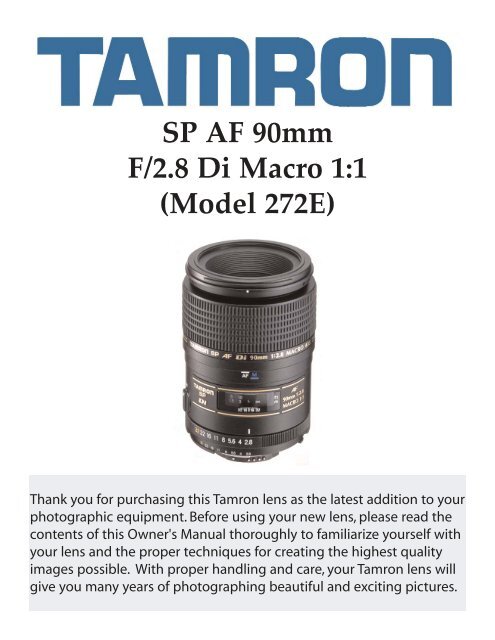
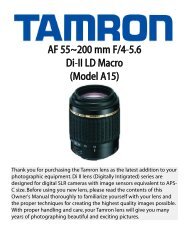

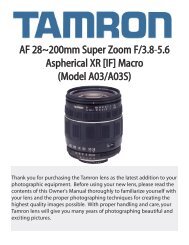
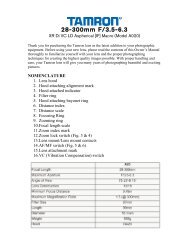
![SP AF 300mm F/2.8 LD [IF] for Canon (Model 360EE) - Tamron](https://img.yumpu.com/27036206/1/190x245/sp-af-300mm-f-28-ld-if-for-canon-model-360ee-tamron.jpg?quality=85)
![SP AF17-50mm F/2.8 XR Di LD Aspherical [IF] - Tamron](https://img.yumpu.com/27036204/1/190x245/sp-af17-50mm-f-28-xr-di-ld-aspherical-if-tamron.jpg?quality=85)
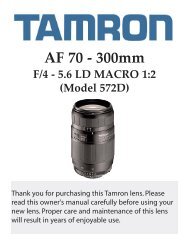
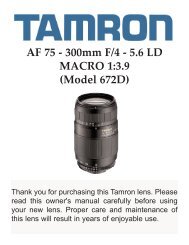
![AF 18~250 mm F/3.5-6.3 Di-II LD Aspherical [IF] - Tamron](https://img.yumpu.com/27036201/1/190x245/af-18250-mm-f-35-63-di-ii-ld-aspherical-if-tamron.jpg?quality=85)
![AF28-300mm F/3.5-6.3 XR Di LD Aspherical [IF] Macro ... - Tamron](https://img.yumpu.com/27036194/1/190x245/af28-300mm-f-35-63-xr-di-ld-aspherical-if-macro-tamron.jpg?quality=85)
![SP AF 14mm F/2.8 Aspherical [IF] (Model 69E) - Tamron](https://img.yumpu.com/27036192/1/190x245/sp-af-14mm-f-28-aspherical-if-model-69e-tamron.jpg?quality=85)

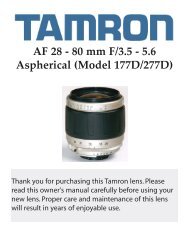
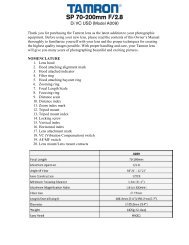
![SP AF 17~50 mm F/2.8 XR Di-II LD Aspherical [IF] (Model ... - Tamron](https://img.yumpu.com/27036181/1/190x245/sp-af-1750-mm-f-28-xr-di-ii-ld-aspherical-if-model-tamron.jpg?quality=85)